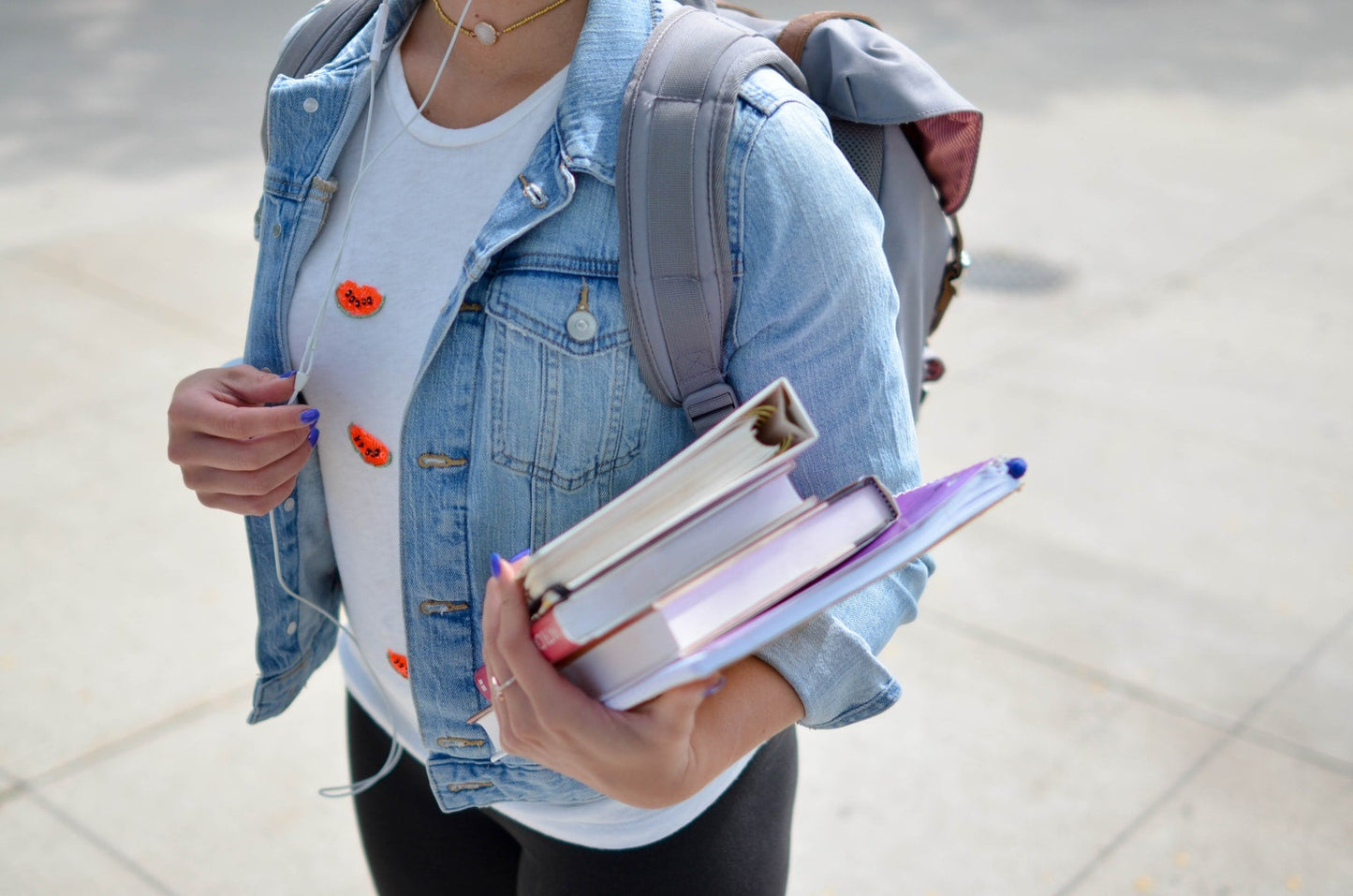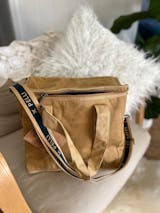
A bright and shiny new school year is expected to come with bright and shiny new school supplies. However, half-filled notebooks, second-hand uniforms, and well-worn books tell the story of a sustainable child. Being educated in an eco-friendly lifestyle can’t be unlearned, so why not start early?
Whatever your child’s age, you can kick off their sustainable journey here with ease. Spend less time, less money, and save our oceans by being thoughtful.
To help you along, here are our tips for a sustainable back-to-school.
The end of the school year.
Let’s start at the end, and work our way back. The final days of any school year are hectic and tiring for everyone. And whilst most of the parents are dropping exhausted into the school holidays, giving an extra hour or two, to put aside the bags, clothes, books, folders, and stationery that can be salvaged, is an hour well spent. Place your school stuff out of sight and mind in a safe, dry place, ready to be revived and given a new-lease in the next school year. Ask your friends or even the school if there are any supplies that they are throwing out that you can also take and store.
Holiday projects
Use the holidays for fun projects with the kids to create and update the covers with home-grown artworks. We love their own art on recycled brown paper for covering worn out books.
Stationery
Notebooks from the previous year are rarely filled to the brim — recover and repurpose for the new year or pass on to parents or siblings.
Scissors, hole punches, and staplers are also reusable essentials. They appear on the stationery list as new each year, but these are some of the easiest items to reuse, as long as they remain functional. Label well and hope for their return. When they do, you can skip the long lines in the stationery supply stores and let the kids use their old fav’s instead.
Pens and Pencils.
The same goes for pens and pencils. Label every single one, and be sure they return to you for reuse in the next year. Make it a challenge for your child to bring home as many as they can at the end of each term and reward them with a treat.
There are new more eco-friendly stationery options on the market all the time, especially available online, so make sure to choose eco-friendly and sustainable brands that don’t use plastic. We love bamboo, and those made from 100% biodegradable plant matter.
Uniforms, clothing, and accessories
School uniforms are usually built to last from synthetic materials. Reuse, re-label and patch and repair to make them last.
Most schools have a Facebook page or group where you can swap, sell and donate (if your school uniforms, and if your school doesn’t have one, you can start one! Uniforms come at a a hefty cost, so most parents won’t want to see them wasted. Get in touch with your school or uniform shop to see what options your school has in place.
School bags
School bags take a beating through the school year. They will get worn out as year goes by, so choose wisely to ensure a worn-out bag doesn’t turn into plastic and/ or microplastics once its use is at an end.
Most school bags are made from synthetic fibers filled with plastic or those with labels like ‘poly’(meaning plastic). Although they can be stronger than natural fabrics, they do turn into microplastics in landfills (and can make their way into waterways from there), so make sure to reuse them for as long as you can.
Remember: Every use makes every bag more sustainable, so if you make your bag last another semester, you have helped the planet.
Look for school bags that are made from natural materials. We love 100% natural canvas. Also, check if it also has a natural lining, as these are often made from poly (plastic) based fabric, even if the external is natural.
Waxed canvas is even better, extra strong, water and spill repellent, dirt-resistant, and more. These are also “vegan-friendly,” “compost-friendly,” and are naturally plastic-free.
If you are to choose a bag made with a plastic-based fabric, choose those with 100% recycled plastics included if you can. . Virgin plastic is one of the planet’s largest problems. Increased demand for recycled plastics boosts the industry and repurposes pollutant plastics.
However, keep in mind that washing plastic based fabrics can still cause the release of hundreds of thousands of plastic fiber particles into the water supply. Some estimates suggest that more than 85 percent of manufactured debris on shorelines is microfiber-based. Both recycled and virgin polyester create the same problem. And, recycled plastic that is blended with cotton is more difficult to recycle again, and can ultimately end up as microplastics in the ocean. It is for this reason that we prefer natural fabrics, which are free of plastic.
Insulated Lunch Bags
Insulated lunch bags are a problem for the planet. Most are made from plastic-based PPL (Polypropylene) or petroleum-based fabric, which are highly toxic. They are low cost, and sometimes also low quality, so they often only last a term or two and then are popped straight into the bin.
Lunch Boxes
These same lunch bags are most often now sold with plastic lunch boxes included. . Again, the lower quality versions can break easily and end up quickly in landfills. They often require single-use plastic wrap for sandwiches and snacks.
One of the greatest frustrations is losing the lid, so label both the lid and base of the container, and only put containers away with both compartments together, so you know when you need to take a trip to the lost property.
We love stainless steel, which is often already made from recycled materials and is continually recyclable, remains strong, non-toxic, BPA free, Phthalate-free, and more. Whilst the cost of good quality 304 stainless steel lunch boxes is more expensive, they are the best for a low-tox life and are rust-proof and long lasting.
Stainless steel boxes often come in leak-proof and airtight options, keeping food fresher, and relinquishing further the need for single-use plastic wrap.
Eco-Friendly Sandwich Wraps
“It’s just a smidge of plastic wrap,” said 4 million mums and dads, 200 times every year. That is a LOT of plastic generated unnecessarily, especially now that there are so many reusable alternatives. Creating a “litterless lunch” is easy peasy with lots of different styles available.
Here are a few of our favourite sandwich wrap styles;
The Envelope Wrap
With the envelope style, you simply pop your sanger in and close the flap. But, this one means you can’t wrap it any tighter if your lunch is small, meaning some ingredients can fall out especially if you have crammed in some green stuff or loose meat. We really don’t want to revert to wrapping it in cling film, so this style isn;t our fav.
Wrappers
These often brightly-coloured wrappers made of recycled PET (polyethylene terephthalate, usually from recycled plastic bottles). These may cost more, and open open out like a treasure map with a wipe-clean inlay. You fold it up and seal it with velcro strips. The presence of velcro strips means you can seal it according to the size of whatever you’re wrapping—sandwiches, samosas, pizza slices and more. So, it feels a little more secure than the envelope style. This one can take a few tries to find the matching velcro strips, but all up a sound solution.
Some wrap styles can be sealed with one long velcro strip. We find this style a lot easier to use and are definitely a fav.
Wrap with a Mat style.
The Wrap with a Mat style also folds out like a map, but adds the extra benefit of a placemat, perfect for these hygiene conscious times, and handy for the germ conscious. This one is made from PEVA (a smooth, food-safe plastic with no fibres to trap food particles.)
Silicone Pouches
Don’t forget the silicone pouch-style wrap, made from kitchen-grade silicone. These options are simple to use and cost-effective. They often come in in packs of varying sizes for easy lunch packing. They are handy and hygienic, and can be used for fruit and other snacks, too.
Water bottle
We live in Australia, so we know to take water everywhere. You can get dehydrated on the way to work or school, let alone after a long day of working and playing. And, in the time of Covid, with water fountains often restricted, a good quality low tox and easily identifiable water bottle is a must.
Here are our tips for choosing a water bottle;
Glass Water Bottle
We love glass, but they break easily and can sometimes be heavy to carry to and fro. So perhaps keep your fav glass water bottle for your desk, and not for transporting.
Stainless Steel Water Bottle
We can’t go past high quality stainless steel water bottles. You have to make sure it is at least 304 quality stainless steel, so avoid the cheap versions that do not specify, Sticking to 304 or 316 stainless steel ensures your bottle is low tox and doesn't leach or rust.
Insulated Water Bottles
Again - Australia, it’s hot. And, lukewarm water on a hot day is not ideal. Choose a double-walled insulated water bottle to keep your kids water cool, even on the hottest Summer days.
Again, label the water bottles and even the lid, to make sure your investment in their health makes it home each day.
Reusable face mask
Last but definitely not the least is a face mask.
Skip the disposables and make or purchase high-quality, breathable reusable masks to reduce your waste.
Buy at least 2 (we have 4 per person - 2 for travel and 2 to leave at school, this means we are never at a loss for a mask and have to revert to disposable). Choose snug-fitting (but not tight) breathable masks so you can wear one while in the wash.
You can also make your own using layers of finely woven cloth (do not use vinyl, polyester and non-breathable materials.)
Hand Sanitiser
Add eco-friendly mist or hand sanitiser to the kids’ everyday essentials list too. Choose cruelty-free, GMO-free, plant-based sanitisers with at least 60 percent alcohol and moisturising elements to avoid dry skin. Do not buy those containing carbomer, which are liquid plastics found in commercial sanitizers. Buy in bulk to save money and packaging, and just refill their travel-sized bottles when needed.


